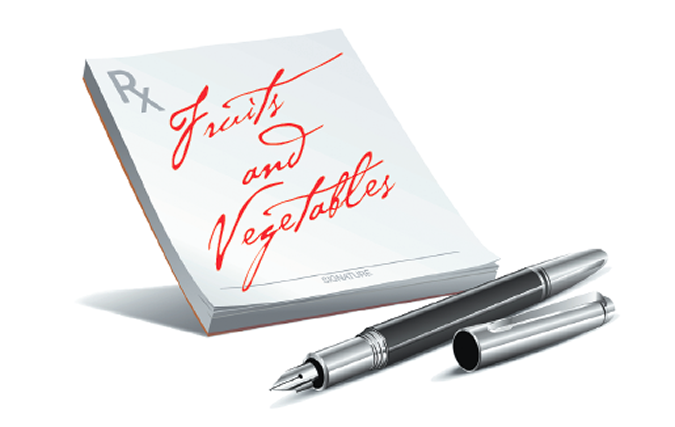
Image © mirror-images | Getty Images
Your blood pressure, blood sugar, or weight is high. Your doctor takes out a prescription pad and writes a prescription for…fruits and vegetables? It may sound far-fetched, but healthy-food prescription programs are already operating in some doctors’ offices, and emerging research suggests such programs have the potential to improve health—saving lives and money.
“Diet-related illness costs hundreds of billions of dollars in preventable healthcare spending, straining the budgets of governments, private businesses, and families,” says Dariush Mozaffarian,
MD, DrPH, dean of the Friedman School of Nutrition Science and Policy and editor-in-chief of Tufts Health & Nutrition Letter. “New research suggests that paying for healthy food through healthcare can save lives and money.”
Prescription Partnerships: Incentive-based fruit and vegetable programs are designed to make healthier food choices more affordable. The federal Supplemental Nutrition Assistance Program (SNAP) offers extra dollars for use at local farmers markets. Other programs provide vouchers for free or reduced-price produce. A number of non-profits across the country are sponsoring “food prescription” programs in doctors’ offices, or helping practices, clinics, and hospitals find funding to support such programs. Typically, the doctor provides a “prescription” that serves as a coupon which can be applied to the purchase of healthy foods like fruits and vegetables at participating retailers.
Healthy Outcomes: Poor nutritional intake is a leading risk factor for many chronic conditions, including coronary heart disease, stroke, and type 2 diabetes, and diet plays a role in high blood pressure, high cholesterol and triglyceride levels, obesity, and cancer. Several studies have found that programs providing incentives to buy fruits and vegetables increase consumption of fresh produce in low-income individuals. One 2016 study, for example, found that participants in the SNAP farmers’ market incentive program consumed more fruits and vegetables after receiving the incentives. (It is important to note that frozen fruits and vegetables are at least as nutritious as fresh, and have a much longer shelf-life, reducing food waste. Canned fruits and vegetables are also acceptable options, as long as consumers are careful about added sugar and salt.)
The question researchers are tackling now is, does the increase in fruit and vegetable intake brought about by incentive programs translate to better health? The small number of studies that have looked into the potential impact of fruit and vegetable incentives on chronic health conditions are encouraging. For example, a 2017 study published in Preventive Medicine Reports tracked the health of 65 participants with uncontrolled type 2 diabetes before and after they received debit cards entitling them to $40 in fresh fruits and vegetables during a 13-week period. While weight and average blood pressure were not different, there was a significant decrease in hemoglobin A1c levels, signaling improved blood sugar control. A similar program providing free healthy produce to people with diabetes also showed significantly improved hemoglobin A1c as well as thousands of dollars in lower healthcare costs.
Yujin Lee, PhD, a postdoctoral fellow at the Friedman School of Nutrition Science and Policy, and colleagues conducted an analysis to help establish the health impacts, costs, and cost-effectiveness of healthy food prescriptions in healthcare. Recently published in PLOSMedicine, the study calculated the effect of offering food prescriptions to adults covered by the federal Medicare or Medicaid programs. “We conducted a computer simulation to estimate the impact of providing a 30 percent discount through Medicare and Medicaid on fruits and vegetables or a range of healthy foods,” says Lee. The model found that electronic debit cards that could be swiped at the point of purchase to cover 30 percent of the cost of fruits and vegetables would prevent about 1.9 million cardiovascular disease (CVD) events and $40 billion in healthcare costs over a lifetime. Covering 30 percent of the cost of several healthy foods (fruits, vegetables, nuts, seeds, plant oils, and seafood) would prevent 3.3 million CVD events, saving $100 billion in healthcare costs.
“According to our findings, subsidizing the cost of healthy foods as part of medical care is a highly cost-effective initiative that could improve the diet and health of Americans,” says Lee.
“We believe a program like this should be incorporated into the healthcare system.”
With or without a prescription, increasing intake of healthy foods improves health. Here are some tips for improving your dietand supporting the health of the general public:
-Increase intake of fruits and vegetables, along with other healthy choices like nuts, seeds, non-tropical plant oils, and seafood.
-Stock your house with fruits and vegetables, both fresh and frozen, so they are readily available during food preparation and for snacking.
-Support policies that make healthy foods more available and affordable through your healthcare coverage and in underserved areas.




















